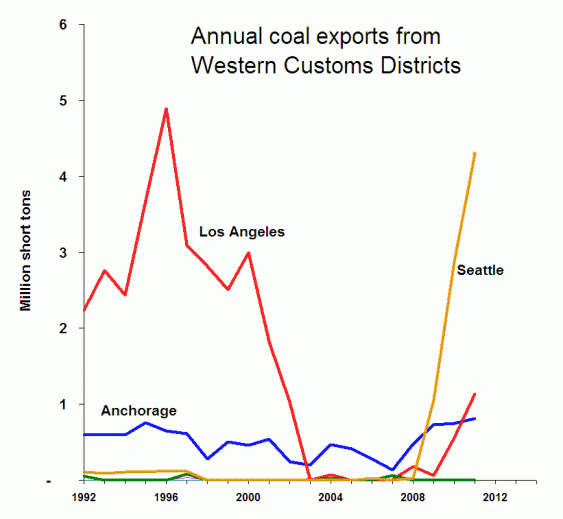Following up on my last analysis of the instability of coal exports historically, here’s another look at the data. It’s confirmation that the Western US has had a rocky run in international coal markets. The following chart depicts annual export volumes by Customs District over the last two decades.

In the past, at least, coal has clearly been a volatile commodity. (The quarterly picture is even more ragged.)
Only three of the Western region’s nine customs districts have registered meaningful levels of coal exports since the early 1990s. The Los Angeles district’s trend line shows the spectacular implosion of the LAXT coal terminal. The Anchorage line shows the fairly modest but still unpredictable shipments from Seward. And the Seattle line shows the sudden rise in Powder River Basin coal making its way north to British Columbia’s Westshore Terminal for shipment to Asia.
Yet as volatile as the past has been, it’s nothing compared to what the future may hold.
Here’s the same data plotted in context of the proposed exports from Cherry Point, Washington.
The coal shipments planned for just that one terminal are so far outside the region’s historical experience that past trends barely register as context. Add in exports planned for Longview, Washington (or Grays Harbor, Washington or Coos Bay, Oregon) and you’d have to extend the vertical axis up to 100 million tons or 130 million tons or more.
There is no historical precedent in the West for the volumes that coal companies want to move to markets in Asia, but history does suggest that coal is an unstable investment.
This post would not have been written without research assistance from Pam MacRae.
Notes: All trend data are derived from the Foreign Trade Division of the US Census Bureau, USA Trade Online. I estimated coal export volumes for 2011 based on the monthly data reported for January through August, the most recent figures available; I assumed that monthly coal exports for the last four months of the year would be the same as the average monthly coal exports during the first eight months. In addition to the districts identified in the charts, the Western Customs Region also includes the districts of the Lower Columbia-Snake (centered on Portland, Oregon); Great Falls, Montana; Nogales, Arizona; Honolulu; and San Diego. More detailed definitions for the Customs’ geographies can be found starting on page 21 of this pdf.










Brett VandenHeuvel
Thanks Eric,
Good info. The volatility shows that betting our future on coal is crazy.